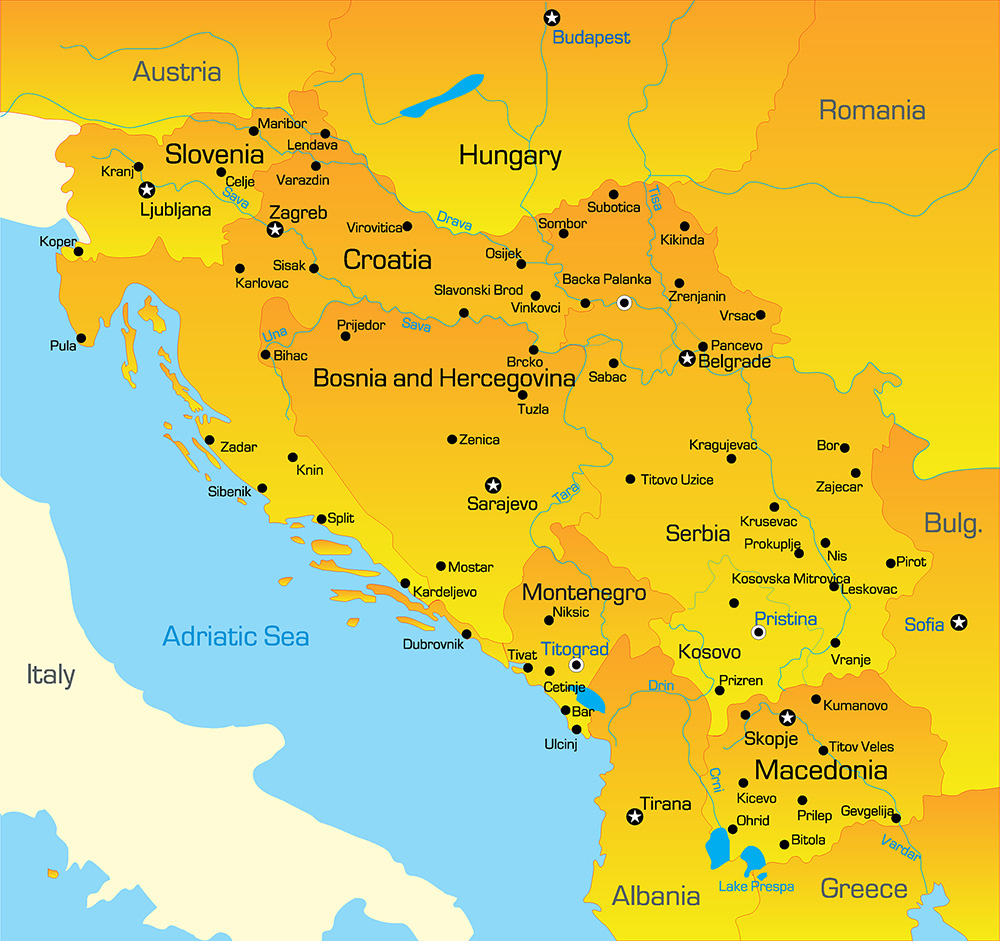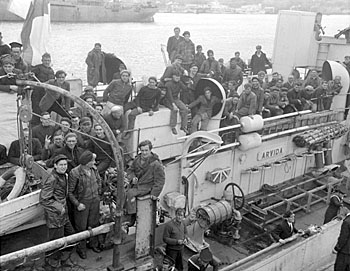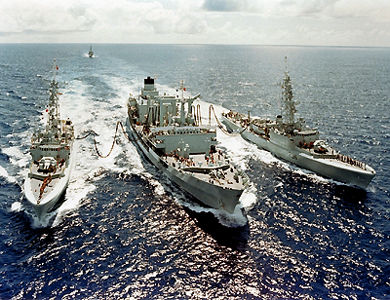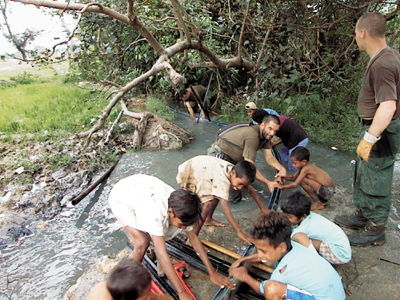Browse "Peacekeeping"
-
Article
12e Régiment blindé du Canada
12e Régiment blindé du Canada (12e RBC) is the junior of three regular armoured regiments in the Canadian Army. The regiment was established in 1871 as a militia infantry battalion and was converted to an armoured regiment in 1936. In 1968, the Regular Force regiment was formed, designated 12e RBC. The regiment or detached squadrons have served in peace operations and in Afghanistan. 12e RBC has been based at CFB Valcartier, Quebec, since 1968 and is part of 5 Canadian Mechanized Brigade Group, 2nd Canadian Division.
"https://d2ttikhf7xbzbs.cloudfront.net/12eRBC/12e RBC commem envelope.jpg" // resources/views/front/categories/view.blade.php
https://d2ttikhf7xbzbs.cloudfront.net/12eRBC/12e RBC commem envelope.jpg
-
Article
Battle of Medak Pocket
In 1993, during the civil war in the former Yugoslavia, Canadian peacekeepers with the United Nations (UN) advanced into disputed territory in Croatia with orders to implement the Medak Pocket ceasefire agreement between the Croatian Army and Serbian irregular forces. Soldiers of the 2nd Battalion, Princess Patricia’s Canadian Light Infantry (2 PPCLI), came under Croatian attack for more than 15 hours. In the firefight that ensued – the most significant combat experienced by Canadians since the Korean War – 2 PPCLI held its ground and preserved the UN protected zone. UN Secretary-General Boutros Boutros-Ghali said the Canadian soldiers brought credit to their profession, saved lives, and enhanced the credibility of UN peacekeeping forces.
"https://d2ttikhf7xbzbs.cloudfront.net/media/media/ad8d859c-5f66-4adc-8054-75dd683d6cf7.jpg" // resources/views/front/categories/view.blade.php
https://d2ttikhf7xbzbs.cloudfront.net/media/media/ad8d859c-5f66-4adc-8054-75dd683d6cf7.jpg
-
Article
Canadian Peacekeepers in Cyprus
The United Nations Force in Cyprus (UNFICYP) was established in 1964 to prevent intercommunal fighting between the Greek Cypriot majority and the Turkish Cypriot minority. Canadian peacekeepers were the first to arrive and remained in strength until 1993. Since then, Canada has provided one staff officer to UNFICYP headquarters on a yearly rotational basis. More than 33,000 Canadians served in Cyprus; 28 died there.
"https://d2ttikhf7xbzbs.cloudfront.net/media/media/50aaa656-14dd-487f-949d-3bfe5facf6d3.jpg" // resources/views/front/categories/view.blade.php
https://d2ttikhf7xbzbs.cloudfront.net/media/media/50aaa656-14dd-487f-949d-3bfe5facf6d3.jpg
-
Article
Canadian Peacekeepers in Haiti
Since 1990, peacekeepers from the Canadian Armed Forces (CAF) and civilian police forces, including the Royal Canadian Mounted Police (RCMP), have served in Haiti on various United Nations (UN) missions. The purpose of these missions was to help stop the internal violence and civil unrest that had plagued the country for years and help promote and protect human rights and strengthen police and judicial systems.
"https://d2ttikhf7xbzbs.cloudfront.net/media/new_article_images/Peacekeeping/Canadian Peacekeepers in Haiti.jpg" // resources/views/front/categories/view.blade.php
https://d2ttikhf7xbzbs.cloudfront.net/media/new_article_images/Peacekeeping/Canadian Peacekeepers in Haiti.jpg
-
Article
Canadian Peacekeepers in Rwanda
From 1993 to 1995, Canada was a leading contributor to a series of United Nations peacekeeping missions in the African nation of Rwanda. However, the United Nations Assistance Mission for Rwanda (UNAMIR), led by Canadian Major-General Roméo Dallaire, was powerless to prevent the slaughter of 800,000 Rwandans in 1994. Following the genocide, a new contingent of Canadian troops returned to Rwanda as part of UNAMIR II, tasked with restoring order and bringing aid to the devastated population. Hundreds of Canadian soldiers, including Dallaire, returned from their service in Rwanda deeply scarred by what they had witnessed.
"https://d2ttikhf7xbzbs.cloudfront.net/media/new_article_images/Peacekeeping/Peacekeepers in Rwanda.jpg" // resources/views/front/categories/view.blade.php
https://d2ttikhf7xbzbs.cloudfront.net/media/new_article_images/Peacekeeping/Peacekeepers in Rwanda.jpg
-
Article
Canadian Peacekeepers in Somalia
In 1992–93, Canada contributed military forces to UNITAF, a United Nations–backed humanitarian mission in the African nation of Somalia. The mission was hampered by the fact that some of the warring factions in the Somalia conflict attacked the international forces that were trying to restore order and deliver food to a starving population. The Canadian effort was also clouded by the murder of a Somali teenager by Canadian troops. The crime — and alleged cover-up by Defence officials in Ottawa — became one of the most infamous scandals in Canadian history.
"https://d2ttikhf7xbzbs.cloudfront.net/media/new_article_images/e002280232.jpg" // resources/views/front/categories/view.blade.php
https://d2ttikhf7xbzbs.cloudfront.net/media/new_article_images/e002280232.jpg
-
Article
Canadian Peacekeepers in the Balkans
From 1991 to the present, members of the Canadian Armed Forces (CAF) and civilian police forces, including the Royal Canadian Mounted Police (RCMP), have served in peace operations in the Balkans. Their mission was to provide security and stability following the breakup of the Federal Republic of Yugoslavia. Nearly 40,000 Canadians have served in the Balkans, and 23 CAF members died while deployed there.
"https://d2ttikhf7xbzbs.cloudfront.net/media/new_article_images/Peacekeeping/Peacekeepers in Croatia.jpg" // resources/views/front/categories/view.blade.php
https://d2ttikhf7xbzbs.cloudfront.net/media/new_article_images/Peacekeeping/Peacekeepers in Croatia.jpg
-
Article
History of the Armed Forces in Canada
The armed forces are the land, naval and air forces commanded by the federal government for the purpose of defending Canada's security, protecting its citizens, and promoting its strategic interests at home or abroad. The armed forces have evolved since colonial times from small, local militia units to the modern professional military forces of today.
"https://d2ttikhf7xbzbs.cloudfront.net/media/media/27bfbefd-a613-47df-bd35-5e01ef6511ae.jpg" // resources/views/front/categories/view.blade.php
https://d2ttikhf7xbzbs.cloudfront.net/media/media/27bfbefd-a613-47df-bd35-5e01ef6511ae.jpg
-
Article
HMCS Kootenay Disaster
HMCS Kootenay was a destroyer in the Canadian Navy. In 1969, an accident at sea killed 9 sailors and injured 53 others. It was the worst peacetime disaster in the history of the navy.
"https://d2ttikhf7xbzbs.cloudfront.net/media/media/ced5f338-fcf3-463a-9627-1da6d7794b5e.jpg" // resources/views/front/categories/view.blade.php
https://d2ttikhf7xbzbs.cloudfront.net/media/media/ced5f338-fcf3-463a-9627-1da6d7794b5e.jpg
-
"https://d2ttikhf7xbzbs.cloudfront.net/The-Memory-Project/image/14905_600.jpg" // resources/views/front/categories/view.blade.php
https://d2ttikhf7xbzbs.cloudfront.net/The-Memory-Project/image/14905_600.jpg
-
Memory Project Archive
John Liss (Primary Source)
Interview with John Liss.Please be advised that Memory Project primary sources may deal with personal testimony that reflect the speaker’s recollections and interpretations of events. Individual testimony does not necessarily reflect the views of the Memory Project and Historica Canada.
"https://d2ttikhf7xbzbs.cloudfront.net/The-Memory-Project/image/14960_600.jpg" // resources/views/front/categories/view.blade.php
https://d2ttikhf7xbzbs.cloudfront.net/The-Memory-Project/image/14960_600.jpg
-
Memory Project Archive
Ron Grant (Primary Source)
Interview with Ron Grant.Please be advised that Memory Project primary sources may deal with personal testimony that reflect the speaker’s recollections and interpretations of events. Individual testimony does not necessarily reflect the views of the Memory Project and Historica Canada.
"https://d2ttikhf7xbzbs.cloudfront.net/The-Memory-Project/image/15418_600.jpg" // resources/views/front/categories/view.blade.php
https://d2ttikhf7xbzbs.cloudfront.net/The-Memory-Project/image/15418_600.jpg
-
Article
North Shore (New Brunswick) Regiment
The North Shore (NB) Regiment (NS(NB)R) is a bilingual, primary reserve infantry regiment of the Canadian Army. It is part of the 5th Canadian Division, 37th Canadian Brigade Group. The regimental headquarters is located in Bathurst, New Brunswick. Regimental battle honours include Passchendaele, Ypres 1917 and Hill 70 (First World War); the Normandy Landing and the Battle of the Scheldt (Second World War).
"https://d2ttikhf7xbzbs.cloudfront.net/media/new_article_images/NorthShoreRegt/NS(NB)R Badge.jpg" // resources/views/front/categories/view.blade.php
https://d2ttikhf7xbzbs.cloudfront.net/media/new_article_images/NorthShoreRegt/NS(NB)R Badge.jpgR Badge.jpg)
-
Macleans
Peacekeepers Leave East Timor
The job holds less significance to the mandarins in Ottawa. Tremblay and his fellow soldiers from the Royal 22nd Regiment in Valcartier, Que., wound up five months of operations at the end of last week and began preparing to return home.This article was originally published in Maclean's Magazine on March 20, 2000
"https://d2ttikhf7xbzbs.cloudfront.net/media/media/1db7b7a1-dbc0-4403-be0f-8bbfebb8765f.jpg" // resources/views/front/categories/view.blade.php
https://d2ttikhf7xbzbs.cloudfront.net/media/media/1db7b7a1-dbc0-4403-be0f-8bbfebb8765f.jpg
-
Article
Canada and Peacekeeping
Peacekeeping is the term usually applied to United Nations (UN) operations in countries affected by conflict. Peacekeepers work to maintain peace and security, protect human rights and help restore the rule of law. Peacekeepers can be members of the armed forces, police officers or civilian experts. As a result of Lester Pearson's leadership in the 1956 Suez Crisis and Canada's role in the UN Emergency Force he helped create, many Canadians consider peacekeeping part of the country's identity. However, since the 1990s Canada's reputation as a peacekeeping nation has been affected by scandal and by the failure of some overseas missions. Although Canada’s contribution to peace operations has declined since then, Canadian peacekeepers continue to serve overseas in such places as Sudan and the Democratic Republic of Congo. In total, more than 125,000 Canadians have served in UN peace operations. Canadians have also participated in UN-sanctioned peace operations led by NATO and in missions sponsored by the Multinational Force and Observers (MFO). Approximately 130 Canadians have died in peace operations.
"https://d2ttikhf7xbzbs.cloudfront.net/media/media/b52c2243-2c08-4941-9163-e8feea5c4cd3.jpg" // resources/views/front/categories/view.blade.php
https://d2ttikhf7xbzbs.cloudfront.net/media/media/b52c2243-2c08-4941-9163-e8feea5c4cd3.jpg
